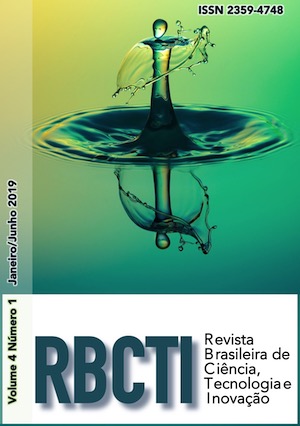Evaluation of the lard oxidative stability added with rosemary extract and rosemary essential oil
DOI:
https://doi.org/10.18554/rbcti.v4i1.3566Palavras-chave:
Lard, Natural antioxidant, Rosemary extract, Rosemary essential oil, Oxidation.Resumo
The production of undesirable compounds from oxidative processes in oils and fats is a problem when it comes to extending shelf life or deep-fat frying foods. In this work the use of rosemary extract and rosemary essential oil in the lard submitted to thermoxidation was evaluated and compared with the synthetic antioxidant TBHQ.The extract obtained from solvent extraction and the rosemary essential oil were submitted to free radical analysis DPPH•and ABTS•+, total phenolic compounds and total flavonoids. The lard was divided into four treatments: lard (control), lard + 100 mg kg-1TBHQ (L + TBHQ), lard + 100 mg kg-1rosemary extract (L + RE) and lard + 100 mg kg-1rosemary essential oil (L + REO). The treatments were submitted to thermoxidation at 180°C, where samples were taken off at intervals of 0, 5, 10, 15 and 20 hours. The samples were analyzed for free fatty acid content, peroxide index and conjugated dienes. The extract showed better antioxidant potential when compared to the essential oil (15.20 and 18.51 mg mL-1for EC50; 917.87 and 321.71 ?mol ET mL-1, respectively). The analysis for total phenolics compounds and total flavonoids showed no statistical difference (99.55 and 80.88 mg EAG L-1; 29.79 and 31.42 ?g ER mL-1, respectively). During the analysis of the thermoxidated lard, the rosemary essential oil showed results as favorable as those obtained by the antioxidant TBHQ, showing that the antioxidants from natural source can be a good alternative to synthetics ones.
Referências
ALADEDUNYE, F.; MATTHÄUS, B. Phenolic extracts from Sorbus aucuparia (L.) and Malus baccata (L.) barriers: antioxidant activity and performance in rapeseed oil during frying storage. Food Chemistry, v. 159, p. 273-281, 2014.
ALMEIDA-DORIA, R. F.; REGITANO-D'ARCE, M. A. B. Antioxidant Activity of Rosemary and Orégano Ethanol Extracts in Soybean Oil Under Thermal Oxidation. Ciência e Tecnologia de Alimentos, v. 20, n. 2, 2000.
ANGELO, P. M.; JORGE, N. Efeito oxidante do extrato de coentro e palmitato de ascorbila na estabilidade oxidativa do óleo de girassol. Revista do Instituto Adolfo Lutz, v. 67, n. 1, p. 34-38, 2008.
AOCS. AMERICAN OIL CHEMISTS SOCIETY. Official methods and recommended practices of the American Oil Chemists' Society. 6. ed. Chicago: AOCS, 2009.
BOTTERWECK, A. A. M. et al. Intake of Butylated Hydroxyanisole and Butylated Hydroxytoluene and Stomach Cancer Risk: Results from Analyses in the Netherlands Cohort Study. Food and Chemical Toxicology, p. 599-605, 1999.
BRAND-WILLIAMS, W.; CUVELIER, M. E.; BERSET, C. Use of a free radical method to evaluate antioxidant activity. LWT - Food Science and Technology,p. 25-30, 28 1995.
BRASIL. Decreto nº 50040, de 24 de janeiro de 1961. Dispõe sobre Normas Técnicas Especiais Reguladoras do Emprego de Aditivos Químicos a Alimentos. Disponivel em: http://portal.anvisa.gov.br/documents/33916/391619/DECRETO+N%C2%BA+50.040%2C+DE+24+DE+JANEIRO+DE+1961.pdf/bb735327-8381-4966-b9d9-627e158d6bcf. Acesso em: 30 nov. 2018.
BRASIL. Resolução RDC nº 270 de 22 de setembro de 2005. Regulamento técnico para óleos vegetais e creme vegetal. Disponivel em: http://www.oliva.org.br/wp-360 content/uploads/2016/11/resolucao-rdc-n270-22-09-2005.pdf. Acesso em: 10 de dez. de 361 2018.
BRASIL. Decreto nº 9.013 de 29 de março de 2017. Regulamento da Inspeção Industrial e Sanitária de Produtos de Origem Animal - RIISPOA. Disponivel em: http://www.agais.com/normas/riispoa/riispoa_titulo7a.pdf. Acesso em: 1 de nov. de 2018.
CASAROTTI, S. N.; JORGE, N. Antioxidant activity of rosemary extract in soybean oil under thermoxidation. Journal of Food Processing and Preservation, v. 38, n. 1, p. 136–145, 2014.
FANG, X.; WADA, S. Enhancing the antioxidant effect of α-tocopherol with rosemary in inhibiting catalyzed oxidation caused by Fe2+ and hemoprotein. Food Research International, v. 26, n. 1, p. 405-411, 1993.
GORDON, M. H.; KOURIMSKÁ, L. Effect of antioxidants on losses of tocopherols during deep-fat frying. Food Chemistry, v. 52, n. 1, p. 175-177, 1995.
KUSKOSKI, E. M. et al. Aplicacíon de diversos métodos químicos para determinar actividad antioxidante en pulpa de frutos. Ciência e Tecnologia de Alimentos, v. 25, n. 4, p. 726-732, 2005.
MORAIS, S. M. D. et al. Ação antioxidante de chás e condimentos de grande consumo no Brasil. Revista Brasileira de Farmacognosia, p. 315-320, 2009.
OIL World Annual. Oil World, 2018. Disponível em: <https://www.oilworld.biz/t/publications/annual>. Acesso em: 17 de dez. de 2018.
POVH, J. A.; SANTOS, F. B.; SILVA, K. R. Teor de fenóis totais e flavonoides em quatro espécies do gênero Hyptis Jacq. ocorrentes no cerrado stricto sensu. Brazilian Geographical Journal: Geosciences and Humanities research medium, v. 3, n. 2, p. 520-528, 2012.
RE, R. et al. Antioxidant activity applying an improved ABTS radical cation decolorization assay. Free Radical Biology and Medicine, v. 26, n. 9-10, p. 1231-1237, 1999.
RESENDE, E. L. ABCS 60 Anos: A Suinocultura Além da Porteira. 1ª. ed. Brasília: Duo Design Comunicação, 2014.
SCHERER, R.; GODOY, H. T. Antioxidant activity index (AAI) by the 2,2-diphenyl-1-picrylhydrazyl method. Food Chemistry, v. 112, n.3, p. 654-658, 2009.
SILVA, A. C.; CURY, Y. S.; SALOMÃO, R. S. Utilização de extrato de louro (Laurus nobilis) como antioxidante natural em óleo de soja termoxidado. In: V Simpósio de Engenharia e Ciência de Alimentos, 5, 2016, São José do Rio Preto.
SINGLETON, V. L.; ROSSI, J. A. Colorimetry of total phenolics with phosphotungstic. American Journal of Enology and Viticulture, v. 16, n. 3, p. 144-158, 1965.
SOBRINHO, T. J. D. S. P. et al. Validação de metodologia espectrofotométrica para quantificação dos flavonóides de Bauhinia cheilantha (Bongard) Steudel. Revista Brasileira de Ciências Farmacêuticas, v. 44, n. 4, p. 683-689, 2008.
VENKATESH, R.; SOOD, D.; SHIVKUMAR, S. A Review of the Physiological Implications of Antioxidants in Food. 2011. Dissertação (Graduação em Ciência) ˗̶ Worcester Polytechinic Institute, Worcester.
WU, J. W. et al. Elucidation of the chemical structures of natural antioxidants isolated from rosemary. Journal of the American Oil Chemists’ Society, v. 59, n. 1, p. 339-345, ago. 1982.
Downloads
Publicado
Edição
Seção
Licença
Copyright (c) 2019 Revista Brasileira de Ciência, Tecnologia e Inovação

Este trabalho está licenciado sob uma licença Creative Commons Attribution-NonCommercial-ShareAlike 4.0 International License.






